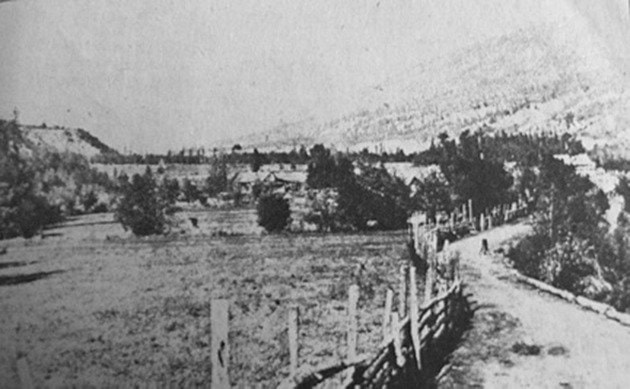As told to Ruth Phillips by Jack Moilliet
The year 1907 found Tam Moilliet in England at the time of his father’s death. There he again met his former sweetheart, and the two planned to be married. Tam returned to his preemption and began to feverishly clear land, build a home, and prepare for the coming of his bride from England.
When these two agreed to meet in Kamloops in 1909, Tam promised to make the date no matter what, even if he should have a broken leg. As it turned out, Tam actually did manage to break his leg at the time. Nevertheless, he arrived in Kamloops on schedule, travelling by canoe and coming to meet her on crutches. Tam’s bride was Mary Tregenna Stephens.
On the day after the wedding Mary bought a beautiful team of horses and a brand new Studebaker wagon. With this rig Tam and Mary travelled up the valley past Chu Chua and on to Mosquito Flats in Blackpool.
The trip was finished by pack train. Some pieces of furniture, including Mary’s beautiful 1850 grand piano shipped all the way from England, had to be left somewhere along the line to be collected later somehow.
Needless to say, the new lifestyle was a complete change for Mary. Arriving at this crudely-constructed log cabin without even the faintest knowledge of wilderness living Mary somehow managed. She was in for a great supply of adventure.
First in a lifetime series of adventures came only nine and one-half months after her arrival. She was traveling by canoe with Tam and Tam’s brother. They were heading for Kamloops for the birth of their first baby when, near the mouth of the Raft River, they came upon an ice jam.
The river was rushing along rapidly here to compensate for the pile-up of masses of ice along the banks of the river. Their canoe was swept up in the strong current heading for its destruction. Mary, Tam and Tam’s brother could see no chance of survival.
As the canoe was just about to be swept underwater Tam made a last-ditch attempt to prevent the canoe from going under. He quickly threw his paddle across from the canoe to the ice.
Miraculously, it held the canoe which bounced. Tam jumped onto the ice and somehow managed to pull the canoe and its occupants to safety.
The three then left their canoe and walked through three feet of snow until they arrived at what was later to become the Haywood place. It was here that they borrowed a team and a sleigh for the remainder of their journey to Kamloops where their first child, Ted, was born in late December. It was not until the following spring that they were able to return to their ranch.
Their place soon became known as Aveley Ranch, and it wasn’t long before Tam built his first store.
This kept Tam and his brother quite busy, and by 1911 the road had reached as far along the Thompson as Tam and Mary’s ranch. It was in this year that Jack’s sister, Madeline, was born. Again Mary travelled to Kamloops, but this time she took no chances with a canoe. She travelled by steamboat.
In 1912 the railroad construction was to begin. It was also at about this time that the post office came into operation. Peavine became known as Vavenby, and a construction camp was set up right across the river from Tam’s place. As a result of this, Tam built his second store on the other side of the river to be manned by Tam and his brother. A ferry had just been built there.
Tam increased his livestock of cattle and hogs, and in the year 1913 he bought his first flock of sheep from a farmer near Louis Creek. These he trailed up the valley to Birch Island along the railroad right-of-way before the steel had been laid, travelling the remaining distance by trail. Tam had approximately 50 sheep at this time.
When the war broke out, Tam’s brother, being single, joined the forces from which he never returned. Tam continued alone caring for the store and the livestock. In 1917 he increased his sheep, importing many from Alberta, and it wasn’t very long before he had approximately 500 sheep.
The winter of 1917 was dreadful. It was long and it was cold, but despite many hardships, Mary and Tam and their two young children survived the winter.
 Jack was born in the year 1919. Once more making the trip to Kamloops, Mary travelled by railroad this time.
Jack was born in the year 1919. Once more making the trip to Kamloops, Mary travelled by railroad this time.
During these teen years this country really filled up with settlers and homesteaders. However, with the outbreak of war, many were never to return.
Tam was responsible for starting up the local school and also the Farmers Institute. Despite the incredible sheep losses due to predators, wood ticks, and mismanagement, Tam continued in his sheep-raising venture. He seemed to thrive on challenges.
When finally their numbers began to increase Tam began running his sheep on the range, taking them up to alpine country. Later on this was to become a community venture as the farmers joined together and jointly took their flocks up into the mountains.
Editor's Note: The above story from the Jan. 8, 1975 issue of the Times was part of a series written by former Times reporter Ruth Phillips.
Inset photo: Jack Moilliet feeds a lamb.
Below: Tam Moilliet's first store.

